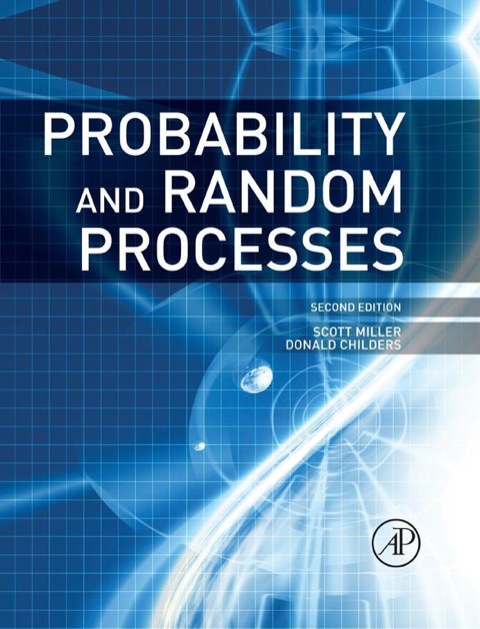Description
Efnisyfirlit
- Cover Image
- Table of Contents
- Title
- Copyright
- Preface
- Chapter 1. Introduction
- 1.1 A Speech Recognition System
- 1.2 A Radar System
- 1.3 A Communication Network
- Chapter 2. Introduction to Probability Theory
- 2.1 Experiments, Sample Spaces, and Events
- 2.2 Axioms of Probability
- 2.3 Assigning Probabilities
- 2.4 Joint and Conditional Probabilities
- 2.5 Basic Combinatorics
- 2.6 Bayes’s Theorem
- 2.7 Independence
- 2.8 Discrete Random Variables
- 2.9 Engineering Application—An Optical Communication System
- Chapter 3. Random Variables, Distributions, and Density Functions
- 3.1 The Cumulative Distribution Function
- 3.2 The Probability Density Function
- 3.3 The Gaussian Random Variable
- 3.4 Other Important Random Variables
- 3.5 Conditional Distribution and Density Functions
- 3.6 Engineering Application: Reliability and Failure Rates
- Chapter 4. Operations on a Single Random Variable
- 4.1 Expected Value of a Random Variable
- 4.2 Expected Values of Functions of Random Variables
- 4.3 Moments
- 4.4 Central Moments
- 4.5 Conditional Expected Values
- 4.6 Transformations of Random Variables
- 4.7 Characteristic Functions
- 4.8 Probability-Generating Functions
- 4.9 Moment-Generating Functions
- 4.10 Evaluating Tail Probabilities
- 4.11 Engineering Application—Scalar Quantization
- 4.12 Engineering Application—Entropy and Source Coding
- Chapter 5. Pairs of Random Variables
- 5.1 Joint Cumulative Distribution Functions
- 5.2 Joint Probability Density Functions
- 5.3 Joint Probability Mass Functions
- 5.4 Conditional Distribution, Density, and Mass Functions
- 5.5 Expected Values Involving Pairs of Random Variables
- 5.6 Independent Random Variables
- 5.7 Jointly Gaussian Random Variables
- 5.8 Joint Characteristic and Related Functions
- 5.9 Transformations of Pairs of Random Variables
- 5.10 Complex Random Variables
- 5.11 Engineering Application: Mutual Information, Channel Capacity, and Channel Coding
- Chapter 6. Multiple Random Variables
- 6.1 Joint and Conditional PMFs, CDFs, and PDFs
- 6.2 Expectations Involving Multiple Random Variables
- 6.3 Gaussian Random Variables in Multiple Dimensions
- 6.4 Transformations Involving Multiple Random Variables
- 6.5 Estimation and Detection
- 6.6 Engineering Application: Linear Prediction of Speech
- Chapter 7. Random Sums and Sequences
- 7.1 Independent and Identically Distributed Random Variables
- 7.2 Convergence Modes of Random Sequences
- 7.3 The Law of Large Numbers
- 7.4 The Central Limit Theorem
- 7.5 Confidence Intervals
- 7.6 Random Sums of Random Variables
- 7.7 Engineering Application: A Radar System
- Chapter 8. Random Processes
- 8.1 Definition and Classification of Processes
- 8.2 Mathematical Tools for Studying Random Processes
- 8.3 Stationary and Ergodic Random Processes
- 8.4 Properties of the Autocorrelation Function
- 8.5 Gaussian Random Processes
- 8.6 Poisson Processes
- 8.7 Engineering Application—Shot Noise in a p–n Junction Diode
- Chapter 9. Markov Processes
- 9.1 Definition and Examples of Markov Processes
- 9.2 Calculating Transition and State Probabilities in Markov Chains
- 9.3 Characterization of Markov Chains
- 9.4 Continuous Time Markov Processes
- 9.5 Engineering Application: A Computer Communication Network
- 9.6 Engineering Application: A Telephone Exchange
- Chapter 10. Power Spectral Density
- 10.1 Definition of PSD
- 10.2 The Wiener–Khintchine–Einstein Theorem
- 10.3 Bandwidth of a Random Process
- 10.4 Spectral Estimation
- 10.5 Thermal Noise
- 10.6 Engineering Application: PSDs of Digital Modulation Formats
- Chapter 11. Random Processes in Linear Systems
- 11.1 Continuous Time Linear Systems
- 11.2 Discrete-Time Linear Systems
- 11.3 Noise Equivalent Bandwidth
- 11.4 Signal-to-Noise Ratios
- 11.5 The Matched Filter
- 11.6 The Wiener Filter
- 11.7 Bandlimited and Narrowband Random Processes
- 11.8 Complex Envelopes
- 11.9 Engineering Application: An Analog Communication System
- Chapter 12. Simulation Techniques
- 12.1 Computer Generation of Random Variables
- 12.2 Generation of Random Processes
- 12.3 Simulation of Rare Events
- 12.4 Engineering Application: Simulation of a Coded Digital Communication System
- APPENDIX A. Review of Set Theory
- APPENDIX B. Review of Linear Algebra
- APPENDIX C. Review of Signals and Systems
- APPENDIX D. Summary of Common Random Variables
- APPENDIX E. Mathematical Tables
- APPENDIX F. Numerical Methods for Evaluating the Q-Function
- Index






Reviews
There are no reviews yet.